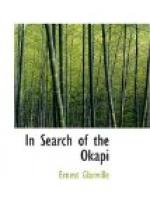“I don’t see any path,” said Venning.
“Nothing in the shape of a foot-bridge that I can see; and it would not be quite safe to fall, would it?” replied Compton, as he glanced down.
Muata went on up into the topmost branches, and, when they followed him, they found a small platform of saplings lashed to the branches by vines, and from this vantage they looked out over a wonderful sea of leaves, reaching unbroken as far as eye could reach, with billows and hollows, patches of light and shade, and splashes of colour where red flowers gleamed. And it was good to see the domed sky, the white clouds racing low, with shadows moving swiftly over that sea of leaves; to see the flight of birds, and to hear the voices of living things.
The tree on which they stood was very tall, but there were others as tall, standing up like rocks out of the sea; and when they grew accustomed to the strange surroundings, they saw something peculiar in the shape of these tree islands. They were cleft through the centre, leaving a narrow passage, quite distinct to any one standing in line—as they were, for instance—with the domed head of a tall tree about three hundred yards away.
“That is our way,” said Muata.
“But where is the foothold?”
Muata pointed to notches cut in a lateral branch, and walked to the end of it, steadying himself by holding to a guiding branch above; then passed over the slight intervening distance between the last notch and the next tree by swinging on a vine tendril, otherwise a “monkey-rope.”
The others followed very gingerly, for the feat was like walking on a yard-arm, but each in turn reached the farther tree. After a little, as they went on, now walking, now swinging, they all were able to pick up the singular track by the notches, by the lay of the lateral branches, and by the absence of projecting twigs along the course. These had all been cut back, leaving a sort of tunnel, not easily discernible, however, because of its undulating character to accommodate itself to the varying height of the trees. They very soon found two obstacles in the way of easy progress, due to the small size of the engineers who had designed this extraordinary road. In the first place, the notches on the branches were too small; and in the next, the tunnel was too low for their height, so that they had to stoop; while it was also evident that the overland swing-bridges between the trees were too frail for their weight. They quickly, therefore, resorted to their Ghoorka knives and to the rope. Venning, being the lightest, crossed over first by the monkey vine-bridge, when he made the rope fast to his end. It was then secured at the other, enabling the heavy weights, Mr. Hume and the chief, to pass next, Compton bringing up the rear with the rope round his waist, to guard against a fall in case of accident. Naturally, their progress was at first very slow, though not so much slower than it would have been had they to force a way through the undergrowth below; and the river-man found his work cut out to keep pace underneath when at times he encountered dense thickets.




